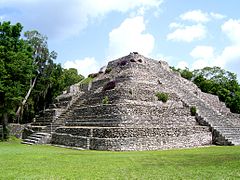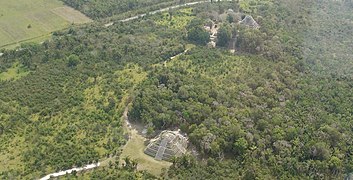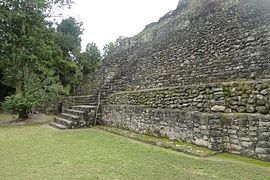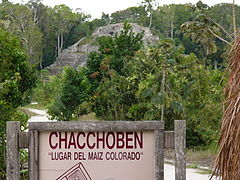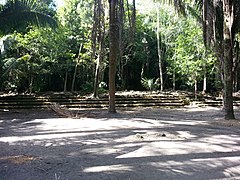Chacchoben
This article needs additional citations for verification. (April 2015) |
Chacchoben | |
|---|---|
Maya Site | |
Central Daylight Time ) |
Chacchoben (chak-CHO-ben; Maya for "the place of red corn") is a Maya ruin approximately 110 mi (177 km) south of Tulum and 7 mi (11 km) from the village from which it derives its name.
History
Settlement by the Maya at the site is estimated at 200 BC, and the structures date from 700 AD. It is characterised by large temples and massive platform groups.[1]
Modern discovery
In the 1940s a farm was established near the site by the Cohuo family. The site was reported visited by archeologist Loring Hewen and briefly described in a letter to ethnohistorian Ralph Roys in 1962. The principal pyramid was apparently then still used as a site for religious worship.
Restoration
In 1994 the Mexican
Chacchoben today
Visitors to the site today walk a circular path that includes three excavated and restored pyramids, as well as many walls and staircases. Excavation is continuing on several mounds which are known to contain further buildings. Some structures still bear traces of the red paint with which they were originally coated, and
The surrounding jungle is characterized by abundant species of fauna, such as deer, peccary, armadillo, gray fox, spider monkey and howler monkey. Deeper into the jungle, more dangerous animals like jaguar, ocelot, puma and tapir can be found.
Image gallery
-
Mayan Temple in Chacchoben, February 2022
-
Temple Pyramid at Chacchoben, August, 2007
-
View of the ruins at Chacchoben from the air
-
Temple Pyramid at Chacchoben from tourist pathway
-
Chacchoben Maya Ruins
-
Ruins in jungles, Chacchoben
-
Sign and Temple Pyramid
-
Along the path between the larger temples there is a small grouping of stone footings and stairs from some of the homes built on this site.
External links
References
- ISBN 9780816526703. Retrieved 24 April 2015.
- ^ {Loring Hewen, New York, to Ralph Roys, Seattle, 20 August 1962, The Ralph L. Roys Papers, Accession 1712-72-17, Special Collections, The University of Washington.}
- ISBN 9780816524419.


